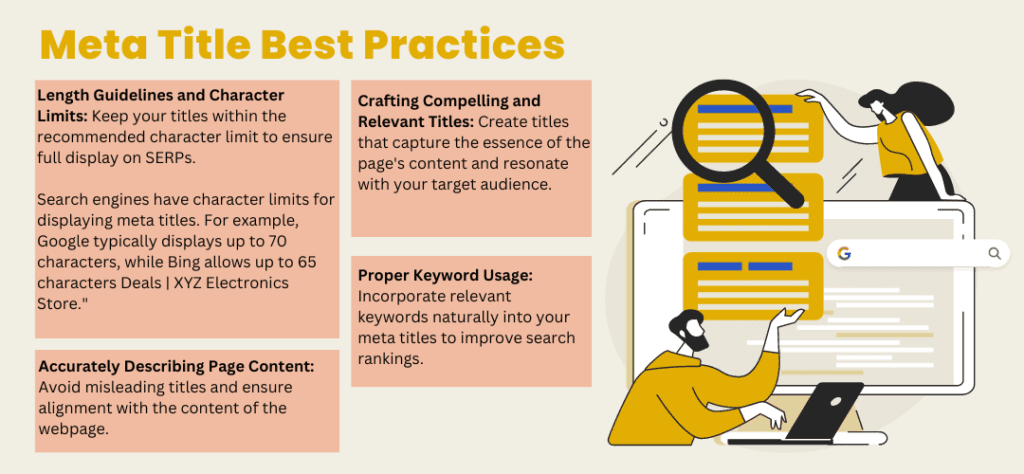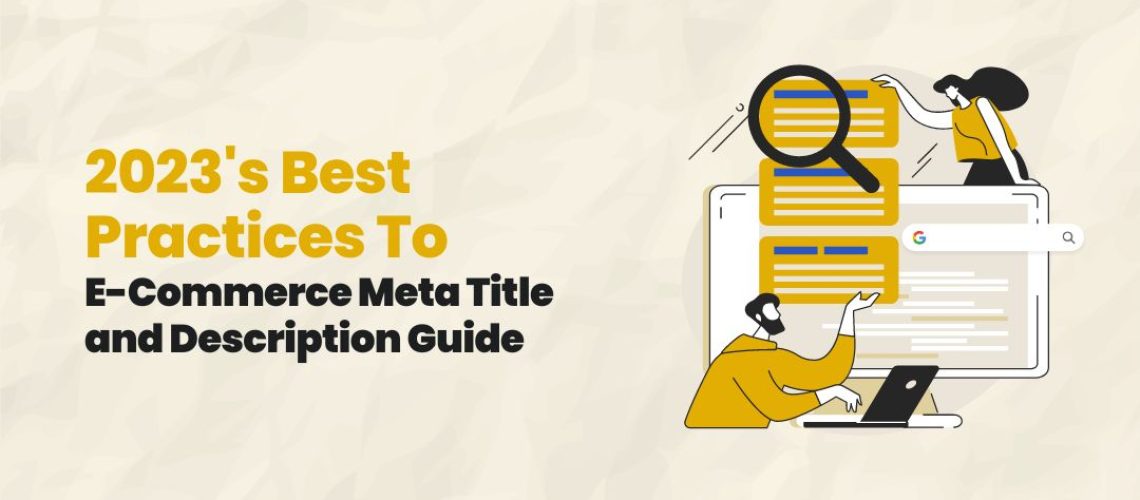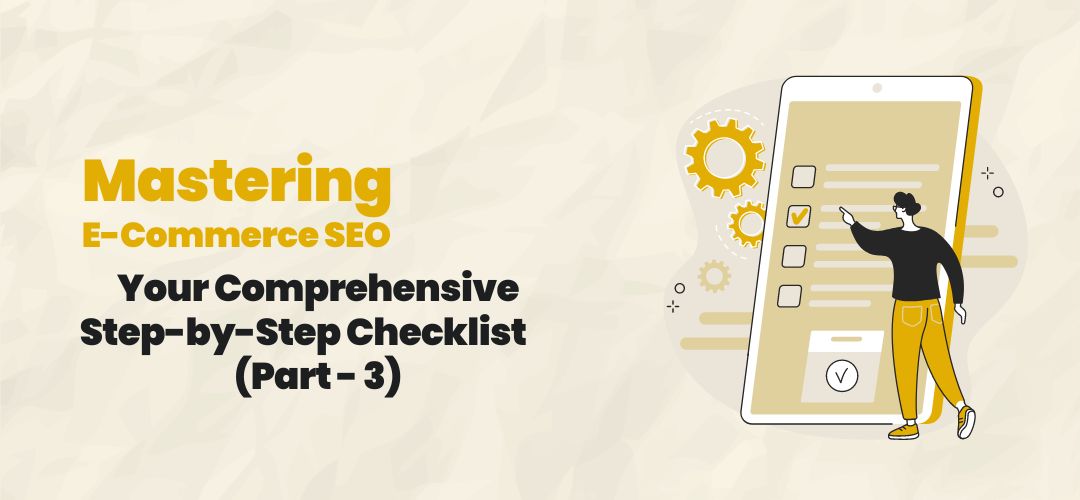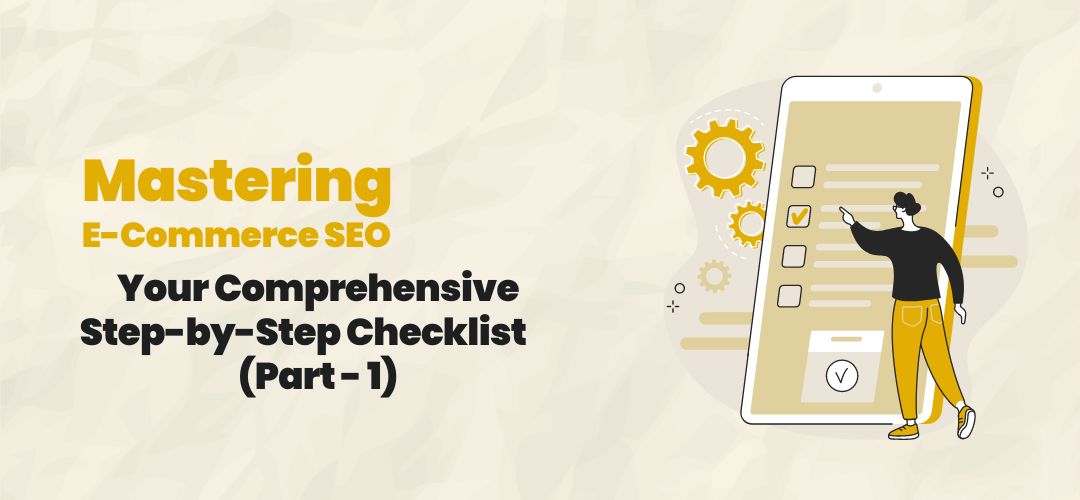Are you ready to navigate the fast-paced world of e-commerce, where competition is fierce and attention spans are short? In this highly competitive landscape, every element of your online presence matters. One essential component that can significantly impact your website’s visibility and click-through rate (CTR) on search engine results pages (SERPs) is the art of crafting effective meta titles and descriptions for E-commerce business.
In this comprehensive guide, we will delve into the best practices for optimizing meta titles and descriptions in 2023. Specifically tailored for e-commerce businesses seeking to thrive in the digital landscape, these strategies will help you stand out amidst the crowd and attract the right audience to your online store.
Definition and Purpose of Meta Titles and Descriptions:
Before diving into the intricacies of optimization, let’s understand the fundamental role of meta titles and descriptions. Meta titles are HTML elements that provide a concise and informative title for a webpage. On the other hand, meta descriptions are brief snippets that offer a glimpse into the page’s content, encouraging users to click through and visit your website.
Meta titles and descriptions play a critical role in attracting organic traffic to your e-commerce website. They serve as the first point of contact between your webpage and potential visitors on search engine results pages. When a user performs a search query, search engines display relevant search results, with meta titles and descriptions serving as the primary text elements. Here’s an example:
Example:
Meta Title: “Buy Trendy Women’s Clothing Online | ABC Fashion Store”
Meta Description: “Discover the latest collection of trendy women’s clothing at ABC Fashion Store. Browse a wide selection of stylish dresses, tops, and more. Shop now for free shipping on all orders.”
In this example, the meta title clearly states what the page offers (trendy women’s clothing) and includes the brand name for brand recognition. Additionally, the meta description provides additional information, enticing users with the promise of a diverse selection and free shipping
Meta Title Best Practices:

A well-crafted meta title can significantly impact your website’s search engine rankings and CTR. To optimize your meta titles effectively:
Length Guidelines and Character Limits:
Keep your titles within the recommended character limit to ensure full display on SERPs.
Search engines have character limits for displaying meta titles. For example, Google typically displays up to 70 characters, while Bing allows up to 65 characters. Exceeding these limits may result in truncated titles, leading to reduced click-through rates. It is essential to keep your meta titles concise and compelling within the given limits.
Example:
Suppose you run an online electronics store and want to optimize the meta title for a product page featuring the latest smartphone. The original title is “Brand X Smartphone | Best Deals, Fast Shipping | XYZ Electronics Store.” However, the title exceeds the character limit. After optimization, the new meta title becomes “Brand X Smartphone | Best Deals | XYZ Electronics Store.”
Crafting Compelling and Relevant Titles:
Create titles that capture the essence of the page’s content and resonate with your target audience.
Your meta title should accurately represent the content of the webpage while piquing the interest of users. Consider incorporating unique selling points or attractive offers to compel users to click through to your website.
Example:
Suppose you manage an online pet supply store and want to optimize the meta title for a new blog post about pet grooming tips. Instead of a generic title like “Pet Grooming Tips,” a more compelling and relevant meta title could be “5 Expert Pet Grooming Tips for a Healthy and Happy Fur Family.”
Proper Keyword Usage:
Incorporate relevant keywords naturally into your meta titles to improve search rankings.
Keywords are essential for signaling to search engines what your webpage is about. However, avoid keyword stuffing, which can harm your search rankings and user experience. Use relevant keywords that align with the content and intent of the page.
Example:
For an e-commerce website selling fitness equipment, the original meta title for a product page might be “High-Quality Treadmills | Best Fitness Equipment | FitHub Store.” After conducting keyword research, an optimized meta title could be “Premium Treadmills for Home Workouts | FitHub Store.”
Accurately Describing Page Content:
Avoid misleading titles and ensure alignment with the content of the webpage.
Misleading meta titles can frustrate users and result in high bounce rates, negatively affecting your SEO. Always ensure that your meta title provides an accurate preview of what users can expect on the webpage.
Example:
Suppose you operate an online gourmet coffee shop and want to optimize the meta title for a product page featuring a new coffee blend. The original title is “Exquisite Colombian Coffee | Best Coffee Beans | CoffeeDelights.” After assessing the content, you realize the coffee blend also contains beans from Brazil. To accurately represent the product, the new meta title becomes “Exquisite Colombian and Brazilian Coffee Blend | CoffeeDelights.”
Meta Description Best Practices:

Meta descriptions are your chance to entice users to click on your link. Follow these best practices for engaging meta descriptions:
Length Guidelines and Character Limits:
Craft concise descriptions that fit within the designated character limit to prevent truncation on SERPs.
Just like meta titles, meta descriptions also have character limits on search engine results pages. Google typically displays up to 160 characters for meta descriptions. Crafting concise and informative descriptions within this limit ensures that users can read the full snippet and understand what your webpage offers.
Example:
For an online gardening supply store with a product page for a new organic fertilizer, the original meta description might be “Our organic fertilizer is the best choice for your garden. It provides essential nutrients for healthy plants and improved soil fertility.” After optimization, the concise and engaging meta description becomes “Boost plant health with our organic fertilizer – enriched with essential nutrients for thriving gardens.”
Writing Concise and Informative Descriptions:
Clearly convey the value proposition of your webpage to attract users’ attention.
Your meta description should quickly and effectively convey the benefits of visiting your webpage. Clearly state the value proposition or unique selling points that set your product or service apart from competitors.
Example:
Imagine you run an online shoe store and want to optimize the meta description for a product page featuring new running shoes. The original description is “Explore our latest collection of running shoes, designed for optimal performance and comfort. Shop now for the best deals.” An improved meta description could be “Unleash your potential with our high-performance running shoes – engineered for comfort and speed.”
Using Persuasive Language and CTAs:
Employ persuasive language and include compelling Calls-to-Action (CTAs) to encourage click-throughs.
Persuasive language in meta descriptions can motivate users to take action. Utilize strong action-oriented verbs and enticing phrases to prompt users to click on your link. Adding a clear CTA can further encourage engagement.
Example:
Suppose you manage an online beauty store and want to optimize the meta description for a product page showcasing a new skincare serum. The original description is “Experience the transformative power of our skincare serum. Try it now for radiant skin.” To make it more persuasive, the revised meta description could be “Revitalize your skin with our transformative serum. Claim your radiant glow – shop now!”
Avoiding Duplicates or Generics:
Create unique meta descriptions for each page to avoid duplicate content issues.
Each meta description should be tailored to the specific content of its corresponding webpage. Using generic or duplicate meta descriptions can confuse search engines and lead to lower rankings.
Example:
Suppose you own an online book store and want to optimize the meta description for a new blog post about summer reading recommendations. Instead of using a generic description like “Check out our summer reading picks,” a unique meta description could be “Embark on a literary journey this summer with our hand-picked book recommendations for every genre.”
Keyword Research for Meta Tags:
An integral part of meta tag optimization is keyword research. Delve into these strategies:
Identifying Relevant and Valuable Keywords: Use keyword research tools to discover keywords that align with your e-commerce business and audience.
Keyword research is the foundation of effective meta tag optimization. Conduct thorough research to identify keywords that potential customers are using to find products or services similar to yours. Look for keywords with high search volumes and relevance to your business.
Example:
Suppose you operate an online electronics store and want to optimize the meta tags for a product category page featuring laptops. Keyword research reveals that “best gaming laptops,” “affordable laptops,” and “thin and light laptops” are popular and relevant keywords for this category.
Utilizing Long-Tail Keywords and User Intent:
Target long-tail keywords that cater to specific user queries and intentions.
Long-tail keywords are more specific and usually longer phrases that potential customers use when they have a clear intent in mind. Targeting long-tail keywords can lead to higher conversion rates as they align with user search intent.
Example:
For an online fashion boutique with a product page featuring women’s summer dresses, long-tail keywords like “floral maxi dresses for weddings” or “casual sundresses for beach vacations” cater to users with specific dress preferences and occasions.
Tools and Resources for Keyword Research:
Explore various keyword research tools to streamline the process.
There are numerous keyword research tools available that can help you discover valuable keywords for your e-commerce business. These tools provide insights into search volume, competition, and also related keywords.
Example:
keyword research tools such as Google Keyword Planner, SEMrush, Moz Keyword Explorer, KeywordTool.io, Ubersuggest, Long Tail Pro, AnswerThePublic, Keyword Surfer, SpyFu, SE Ranking, KWFinder and Serpstat and Ahrefs offer valuable data on keyword performance, search volume trends, and competitor analysis, aiding in your keyword research efforts.
Optimising for Click-Through Rate (CTR):
Increasing your CTR can lead to higher organic traffic and better visibility. Employ these strategies to optimize CTR with meta tags:
Strategies to Improve CTR with Meta Tags:
Implement tactics such as using power words, addressing pain points, or offering unique value propositions in meta tags.
To entice users to click on your link, employ persuasive language and strategies that capture their attention. Utilize power words that evoke emotion, address common pain points, and also highlight unique selling points.
Example:
Suppose you manage an online wellness store and want to optimize the meta tags for a product page featuring organic skincare products. By adding power words like “nourishing,” “rejuvenating,” and “eco-friendly” in the meta title and description, you can enhance the appeal to environmentally-conscious customers seeking effective skincare solutions.
Leveraging Schema Markup and Rich Snippets:
Enhance your listings on SERPs with structured data and rich snippets.
Schema markup allows you to provide additional information to search engines about your content, enhancing the appearance of your listings on SERPs. Rich snippets display extra details, such as ratings, reviews, or product availability, attracting more attention from users.
Example:
If you have an e-commerce website selling tech gadgets and want to optimize the meta tags for a product page featuring a smartphone, you can add schema markup for reviews and product ratings. Additionally, this will make your listing stand out with star ratings directly on the search results, potentially increasing clicks.
Avoiding Common Mistakes:
To maintain accuracy and avoid penalties from search engines, steer clear of these common meta tag errors:
Identifying and Rectifying Errors in Meta Tags:
Regularly audit and update your meta tags to ensure they align with the webpage content.
Keeping your meta tags up-to-date is crucial to prevent misleading or outdated information from appearing on search results. Regularly audit your meta titles and descriptions, especially when you update webpage content or product offerings.
Example:
Suppose you manage an online home decor store and want to optimize the meta tags for a product page featuring a seasonal promotion. If the promotion has ended but the meta tags still indicate the ongoing sale, it could lead to a poor user experience when customers find the discount no longer available.
Ensuring Consistency with Page Content:
Avoid discrepancies between meta tags and the actual content to provide a seamless user experience.
Your meta tags should accurately reflect the content of the webpage they represent. When users click through based on a compelling meta description, they expect to find relevant content that matches their expectations.
Example:
For an e-commerce website selling outdoor camping gear, the meta description for a product page promoting a specific tent model should align with the content of the page. Additionally, If the meta description promises features like “built-in LED lighting” and “detachable gear loft,” the corresponding page must provide information about these features.
Mobile and Responsive Considerations:
In the age of mobile browsing dominance, optimizing meta tags for mobile search results is paramount. Consider the following factors:
Impact of Meta Tags on Mobile Search Results:
Understand how meta titles and descriptions can influence your website’s mobile visibility.
Mobile users represent a significant portion of online traffic. Search engines consider mobile-friendliness when ranking websites for mobile search results. Optimizing your meta tags for mobile enhances the user experience and positively impacts mobile search rankings.
Example:
Suppose you operate an online health and fitness store and want to optimize the meta tags for a product category page featuring exercise equipment. If the meta title is too long and gets truncated on mobile devices, it may lead to lower click-through rates due to users not seeing the full title.
Crafting Mobile-Friendly Meta Titles and Descriptions:
Ensure your meta tags are concise, engaging, and appealing to mobile users.
Mobile users have limited screen space, so crafting concise and engaging meta titles and descriptions is essential to capture their attention quickly. Use language that resonates with mobile users and aligns with their on-the-go needs.
Example:
For a travel agency website offering vacation packages, the meta description for a page promoting a beach resort could be optimized to read: “Escape to Paradise – Book Your Dream Beach Getaway Today!”
Tracking and Measuring Success:
Effectively analyzing the performance of your meta titles and descriptions is crucial for continuous improvement. Utilize the following tools and techniques:
Using Google Search Console and Analytics:
Leverage these tools to monitor click-through rates, impressions, and other relevant metrics.
Google Search Console provides valuable data on how often your webpages appear in search results, their click-through rates, and the keywords that drive traffic. Google Analytics complements this information with insights into user behavior on your website.
Example:
By using Google Search Console, an e-commerce store owner can analyze which product category pages have the highest click-through rates and which ones may need optimization. Additionally, Google Analytics can reveal how long users spend on the site after clicking through from a particular meta description.
Analyzing Click-Through Rates for Improvements:
Identify trends and patterns to optimize your meta tags for higher CTR.
Identify pages with low click-through rates and assess the associated meta titles and descriptions. Experiment with different approaches, such as tweaking the language, highlighting unique selling points, or addressing user pain points, to improve CTR.
Example:
An online fashion retailer can analyze the click-through rates of its product pages based on various meta descriptions. If one particular style of meta description consistently outperforms others, the retailer may replicate that approach for similar product pages to boost overall CTR.
Using CMS and SEO Plugins:
Streamline the process of implementing and optimizing meta tags with popular content management systems (CMS) and SEO plugins:
Implementing Meta Tags with CMS:
Discover how to efficiently add and manage meta titles and descriptions using your CMS platform.
Most modern CMS platforms, like WordPress, Shopify, and also Magento, provide user-friendly interfaces for managing meta tags. Easily edit and update meta titles and descriptions without requiring extensive technical knowledge.
Example:
A small business owner using WordPress can optimize their website’s meta tags by navigating to the SEO plugin’s settings within the CMS dashboard. They can then edit each page’s meta title and description with the plugin’s built-in tools.
Exploring SEO Plugins for Easier Optimization:
Make the most of SEO plugins that offer features for optimizing meta tags effectively.
SEO plugins often provide additional functionalities, such as suggestions for improving meta tags, analyzing keyword density, and ensuring proper formatting.
SEO plugins:
- Yoast SEO: Comprehensive SEO plugin with content optimization and also sitemap generation.
- Rank Math: Powerful SEO plugin with rich snippet support and advanced analysis.
- SEOPress: User-friendly plugin for meta tags optimization and schema markup.
- All in One SEO Pack: Alternative to Yoast SEO with similar features.
- Schema Pro: Adds structured data (schema markup) to enhance search visibility.
- Broken Link Checker: Finds and fixes broken links on your site.
- Redirection: Handles 301 redirects and monitors 404 error pages.
- WP Rocket: Caching plugin to improve site speed and also performance.
- Smush: Optimizes images for faster loading times.
- AMP for WP: Enables AMP support for better mobile SEO.
Example:
A website administrator using an SEO plugin can benefit from automatic meta tag optimization recommendations. For instance, the plugin might suggest incorporating target keywords into meta titles and descriptions to improve search engine rankings.
Updates and Future Trends:
Staying ahead of search engine algorithm changes and future trends is essential for maintaining your competitive edge. Consider the following strategies:
Staying Informed About Algorithm Changes: Keep abreast of updates to search engine algorithms that may impact meta tag optimization.
Search engines continuously refine their algorithms to provide more accurate and relevant search results. Being aware of these changes allows you to adjust your meta tag optimization strategies accordingly.
Example:
If a search engine introduces a new feature, like displaying product prices in meta descriptions, businesses can quickly adapt their meta tags to include this information for a competitive advantage.
Potential Future Trends in Meta Tag Optimization:
Explore emerging trends and practices that could shape meta tag optimization in the future.
By empowering yourself with the knowledge and strategies provided in this guide, you can confidently navigate the dynamic world of meta titles and descriptions. As a result, you will be better equipped to solidify your position as a standout player in the bustling world of e-commerce. Moreover, anticipate advancements in search technology and user behavior to prepare for future changes in meta tag optimization strategies.
Example:
With the increasing adoption of voice search and AI-powered search assistants, businesses might need to optimize their meta tags for voice-friendly queries and adapt their content to voice search semantics.
By empowering yourself with the knowledge and strategies provided in this guide, you can confidently navigate the dynamic world of meta titles and descriptions. As a result, you will be better equipped to solidify your position as a standout player in the bustling world of e-commerce.
So, take action now and start applying these techniques to your meta tags. Monitor your website’s performance through Google Search Console and Analytics, and also make data-driven decisions to improve your click-through rates and search engine rankings.
Visit Prokett for Expert Meta Tag Optimization Services!
For a truly engaging and impactful online presence, consider partnering with Prokett, a leading digital marketing agency. Our team of experts specializes in meta tag optimization and can help you create compelling meta titles and descriptions that drive results. Visit our landing page now to learn more and take your e-commerce business to new heights!







